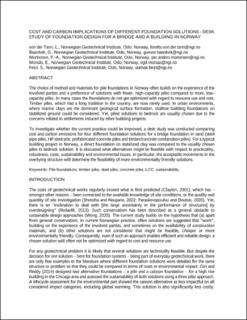Cost and carbon implications of different foundation solutions - Desk study of foundation design for a bridge and a building in Norway
Chapter
Permanent lenke
https://hdl.handle.net/11250/3085287Utgivelsesdato
2023Metadata
Vis full innførselSamlinger
- NGI articles [1061]
Originalversjon
1st Conference on Foundation Decarbonization and Re-use, 21.- 22. March 2023, AmsterdamSammendrag
The choice of method and materials for pile foundations in Norway often builds on the experience of the involved parties and a preference of solutions with fewer, high-capacity piles compared to more, low-capacity piles. In many cases the foundations do not get optimized with regard to resource use and cost. Timber piles, which had a long tradition in the country, are now rarely used. In urban environments, where marine clays are the dominant geological surface formation, shallow building foundations on stabilized ground could be considered. Yet, piled solutions to bedrock are usually chosen due to the concerns related to settlements induced by other building projects.
To investigate whether the current practice could be improved, a desk study was conducted comparing cost and carbon emissions for four different foundation solutions for a bridge foundation in sand (steel pipe piles, HP steel pile, prefabricated concrete piles and timber/concrete combination piles). For a typical building project in Norway, a direct foundation on stabilized clay was compared to the usually chosen piles to bedrock solution. It is discussed what alternatives might be feasible with respect to practicality, robustness, costs, sustainability and environmental issues. In particular, the acceptable movements in the overlying structure will determine the feasibility of more environmentally friendly solutions.
